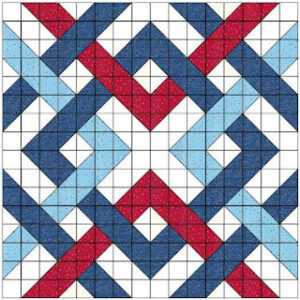Creating a Lattice Quilt block is a fantastic way to add a touch of elegance and complexity to your quilt patterns.
This step-by-step tutorial will guide you through the process of making a beautiful Lattice Quilt block, including all the necessary fabric cuts and measurements.
Follow along and you’ll have a stunning quilt block in no time!

Materials and Fabric Requirements
To get started with your Lattice Quilt block, you will need the following materials:
- Fabric for the lattice strips
- Background fabric
- Rotary cutter and mat
- Ruler
- Sewing machine and thread
- Iron and ironing board
Ensure that you have all your materials ready before you begin. This preparation will make the process smoother and more enjoyable. The fabrics you choose will determine the overall look of your quilt, so consider colors and patterns that complement each other well.
For this tutorial, we will use two main fabrics: one for the lattice strips and one for the background. You will need 1/4 yard of fabric for the lattice strips and 1/2 yard of background fabric. These amounts will be sufficient to create a few blocks, which you can then multiply to make a full quilt.
Cutting the Fabric
Accurate fabric cutting is crucial for a successful Lattice Quilt block. Follow these cutting instructions carefully:
- From the lattice fabric, cut four strips measuring 2.5 inches by 8.5 inches.
- From the background fabric, cut four squares measuring 4.5 inches by 4.5 inches and four rectangles measuring 2.5 inches by 4.5 inches.
Using a rotary cutter and a ruler, make sure your cuts are precise. This accuracy will ensure that your pieces fit together perfectly when sewn. It’s also a good idea to starch your fabric before cutting to minimize fraying and stretching.
Lay out your cut pieces on a flat surface to double-check that you have all the necessary components. This step helps to prevent mistakes and makes the assembly process more straightforward.
Assembling the Lattice Strips
Now that your fabric pieces are ready, it’s time to start assembling the lattice strips. Begin by sewing the 2.5-inch by 8.5-inch lattice strips to the 2.5-inch by 4.5-inch background rectangles. You should have four units in total.
Press the seams towards the lattice fabric. This will reduce bulk and ensure a crisp finish. Use an iron to press the seams carefully, avoiding any distortion of the fabric pieces.
Next, sew these units to the 4.5-inch by 4.5-inch background squares. Align the edges carefully and pin them in place before stitching. Once sewn, press the seams towards the lattice fabric again. You should now have four larger units.
Constructing the Lattice Quilt Block
With your lattice strips assembled, it’s time to put together the Lattice Quilt block. Lay out the four units in a 2×2 grid, ensuring that the lattice strips form a continuous line across the block.
Pin the units together in pairs, then sew along the pinned edges. Press the seams towards the lattice strips. This will help your block lay flat and look more polished. Repeat this process for the other pair of units.
Finally, sew the two pairs together to complete the block. Press the final seam towards the lattice strips. Your Lattice Quilt block should now be fully assembled, with crisp, clean lines and perfect intersections.


Tips for Perfect Lattice Quilt Blocks
Achieving perfect Lattice Quilt blocks can be challenging, but these tips will help you master the technique:
- Use a scant 1/4-inch seam allowance to ensure accurate seam measurements.
- Chain piece your units to save time and maintain consistency.
- Press seams open or to one side as directed to reduce bulk and achieve a flat block.
Consistent seam allowances are key to ensuring that your blocks fit together seamlessly. Using a seam guide on your sewing machine can help maintain this consistency. Additionally, chain piecing allows you to sew multiple units without cutting the thread between them, speeding up the process and improving accuracy.
Pressing seams correctly is crucial for achieving a professional finish. Use a hot iron and press rather than iron to avoid distorting the fabric. Following these tips will help you create beautiful, precise Lattice Quilt blocks every time.
Variations and Design Ideas
The Lattice Quilt block is versatile and can be adapted in various ways to create different designs. Here are some ideas to inspire you:
- Use different fabric colors for the lattice strips to create a multi-colored effect.
- Change the size of the blocks to create a different overall quilt size.
- Combine Lattice Quilt blocks with other quilt patterns to create a unique design.
Experimenting with different fabric choices can lead to stunning results. Consider using a gradient of colors for the lattice strips to create an ombre effect, or mix and match prints for a more eclectic look. Adjusting the size of the blocks allows you to customize the quilt to fit your needs, whether you want a small baby quilt or a large bedspread.
Combining the Lattice Quilt block with other patterns can also create interesting designs. For example, alternating Lattice blocks with plain blocks or other quilt block patterns can add visual interest and complexity to your quilt. The possibilities are endless, so don’t be afraid to get creative!

Finishing Your Quilt
Once you have assembled your Lattice Quilt blocks, it’s time to finish your quilt. This involves adding sashing, borders, and binding to complete the quilt top, followed by quilting and finishing the edges.
Sashing is optional but can help separate the blocks and give the quilt a more defined look. Cut sashing strips to the same width as your lattice strips and sew them between the blocks. Adding borders can frame the quilt and add to its overall size. Choose a fabric that complements your lattice and background fabrics.
Join our VIP list and receive exclusive free patterns. You’ll have daily access to the best designs, delivered straight to your device. Don’t miss this chance to get inspired and improve your projects with new and amazing patterns!
After assembling the quilt top, layer it with batting and backing fabric. Quilt as desired, either by hand or machine. Finally, add binding to the edges to complete your quilt. Congratulations, you have successfully made a beautiful Lattice Quilt!
THE BEST QUILT PATTERNS
Creating a Lattice Quilt block is a rewarding project that can add elegance and sophistication to your quilt patterns. By following this step-by-step tutorial, you can master the technique and create stunning quilt blocks with ease. Remember to use accurate cutting and sewing methods, and don’t be afraid to experiment with different fabrics and designs. Happy quilting!





